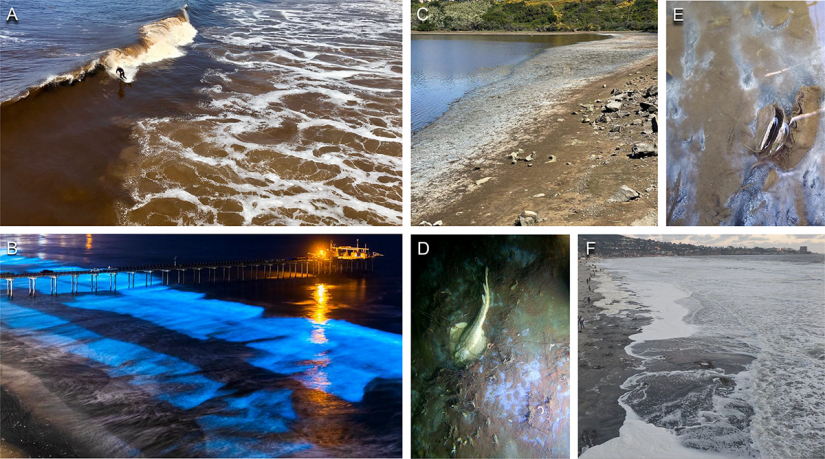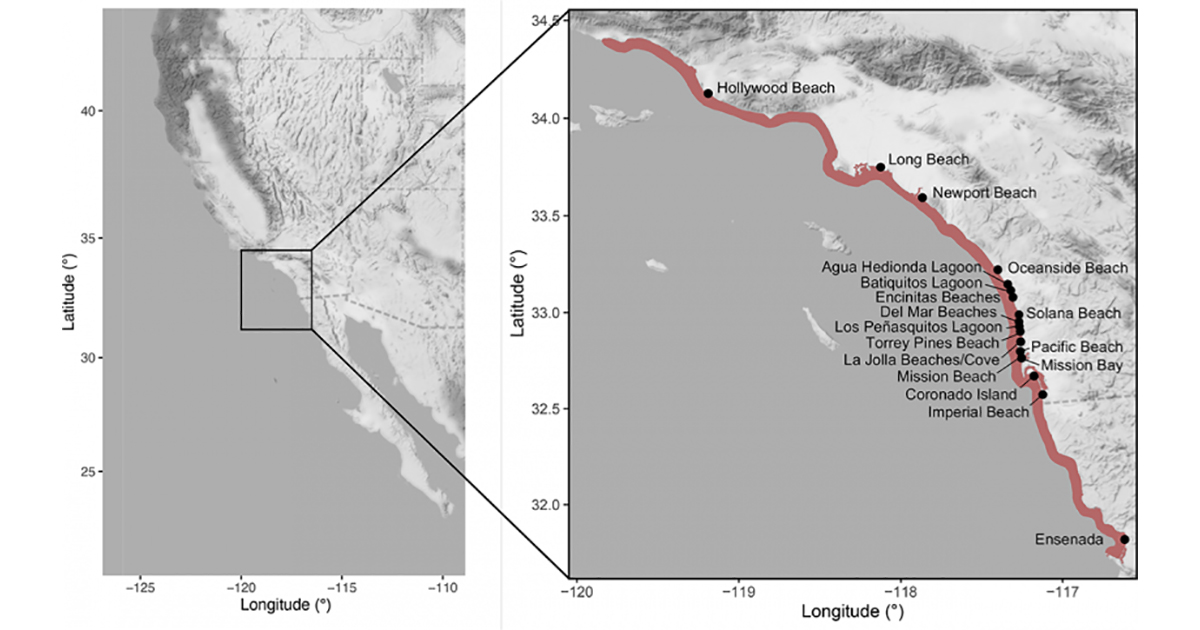In the spring of 2020, a historic red tide event occurred in waters off Southern California. Driven by a bloom of the dinoflagellate Lingulodinium polyedra, this event brought nighttime displays of bioluminescence to beaches along the coast, from Baja California to Santa Barbara. While the bloom gained international attention for its stunning visual displays, it also had significant negative impacts, including mass mortality among fish and other marine organisms.
Marine scientists from UC San Diego’s Scripps Institution of Oceanography, National Oceanic and Atmospheric Administration (NOAA), and other organizations seized the opportunity to study the unprecedented event and its impacts on marine life, both in the wild and in aquariums. In a recent study, this multi-institutional team of 34 researchers identified deteriorating water quality—notably prolonged low oxygen conditions—as a significant factor in the mass mortality event. Their findings were published in the journal Elementa, and featured in a special issue focused on the 2020 red tide.
“Red tides are notoriously difficult to predict and study, so the 2020 event presented a unique opportunity for the marine science community to collaborate and use existing infrastructure to figure out what was causing these die-offs,” said lead author Zachary Skelton, a marine biologist under contract at NOAA’s Southwest Fisheries Science Center (SWFSC) and recent graduate of Scripps Oceanography. “Our paper provides valuable insights into how low- or no-oxygen conditions can harm certain marine species, particularly those inhabiting estuaries and shallow coastal areas.”
The study was informed by data from existing long-term observation programs, alongside reports from community members, field surveys, and case studies from local aquariums that use local seawater to sustain their systems. The researchers found a correlation between extreme changes in water conditions, notably dissolved oxygen and pH levels, and the dynamics of the red tide bloom.
Sensor data along the coastline revealed extreme hypoxic (low oxygen) and hyperoxic (excess oxygen) conditions, especially in estuaries and near-shore coastal environments. These conditions impacted the health of numerous marine species, leading to the documented deaths of thousands of fishes and invertebrates, as well as several seabirds. Case studies from four local aquariums—including Birch Aquarium at Scripps, as well as two experimental aquariums at Scripps Oceanography and one at NOAA SWFSC—indicated that factors beyond large changes in oxygen and pH levels might have contributed to the observed mortality.
Since the red tide coincided with the early stages of the COVID-19 pandemic, the team had to obtain special permission from UC San Diego and other local institutions and authorities to conduct fieldwork. Once these permissions were secured, Skelton, along with Ben Frable, collection manager of marine vertebrates at Scripps Oceanography, visited multiple beaches and estuaries around San Diego to count, photograph, and measure the dead fish and invertebrates.
Their observations and community reports—shared via social media, email, and the citizen science platform iNaturalist—revealed mass die-offs of fish and invertebrates between late April and mid-May 2020, following sharp drops in oxygen levels. Fish die-offs were disproportionately reported in the La Jolla area (including La Jolla Cove, La Jolla Shores Beach, and Scripps Beach), the Encinitas area, and Agua Hedionda Lagoon in Carlsbad. Many of these locations are enclosed or geographically sheltered areas, which limits mixing and makes it easier for blooms to concentrate.
The red tide harmed many different species, but nearshore and bottom-dwelling species fared the worst. “Many of the species that live on or near the seafloor tend to be less mobile,” said Skelton. “These creatures often stick to their preferred habitats, even while experiencing stressful conditions.”
For instance, the spotted sand bass, usually found in shallow, sandy environments, suffered the highest reported mortality among fish species, with hundreds washing up on Encinitas beaches and at Agua Hedionda Lagoon. Similarly, hundreds of California bubble snails were among the most affected invertebrates. Divers also reported deaths of species like topsmelt, round stingray, sarcastic fringehead, sanddabs, rockfish, and thornback guitarfish, which were observed underwater but did not wash ashore. The authors noted that this red tide event did not seem to harm marine mammals or cause more reported strandings than usual.

A photo compilation showing aspects of the 2020 red tide. (A) A surfer in the thick red tide off Scripps Pier, April 24, 2020. (Image credit: Michael Latz.) (B) Bioluminescence of L. polyedra off Scripps Pier, May 14, 2020. (Image credit: Kevin Key Photography.) (C) Bacterial mats at Agua Hedionda Lagoon after a mass mortality event, May 10, 2020. (Image credit: S Anthony.) (D) A dead thornback guitarfish among subtidal bacterial mats in La Jolla Canyon, May 9, 2020. (Image credit: Raph Beresh.) (E) A decaying Pacific oyster surrounded by a bacterial mat in Los Peñasquitos Lagoon, May 20, 2020. (Image credit: Carlos Neira.) (F) Organic-rich sea foam at Scripps Beach caused by the decaying bloom, May 19, 2020. (Image credit: Zach Skelton/SCRIPPS)
Once it was established that a mass mortality event was underway, the team wanted to find out which aspect of the red tide bloom had the biggest impact on marine organisms. Red tides occur when there is a rapid increase or “bloom” in populations of marine algae, typically dinoflagellates or other species of phytoplankton. During the daytime, these organisms photosynthesize by taking up carbon dioxide and producing oxygen. At night, the collective bloom and community respiration draw up the surrounding oxygen while producing carbon dioxide, ultimately causing changes in seawater chemistry across the day/night cycles. At peak bloom, conditions are often hyperoxic for longer periods due to the increased amount of oxygen in the water. As the bloom starts to decline—either due to the natural lifecycle of these organisms or depletion of nearby nutrients—oxygen levels are reduced, often resulting in prolonged hypoxic conditions.
Study co-author and biological oceanographer Lillian McCormick analyzed data from 11 oceanographic sensor packages deployed on moorings off the coast of San Diego. These sensors were deployed at various depths, ranging from 1.5 meters (5 feet) to approximately 100 meters (328 feet), collecting data across estuaries, shallow nearshore environments, and farther offshore.
Shallower waters, particularly within estuaries and lagoons, bore the brunt of the red tide impacts, experiencing prolonged periods of hypoxia. Agua Hedionda Lagoon and Los Peñasquitos Lagoon were the hardest hit, enduring episodes of extreme hypoxia and even anoxia, where there was no oxygen. Construction near Los Peñasquitos Lagoon during the peak bloom led to the complete closure of the lagoon to the open ocean, which likely exacerbated the situation.
"The bloom was heavily concentrated within those estuaries, and likely worsened at one location by its complete closure for a number of weeks," said McCormick, a postdoctoral researcher at California Sea Grant and Scripps Oceanography. "These enclosed spaces don’t see as much flushing or movement of the water as we typically see in deeper, open ocean waters.”
The authors were surprised to find that the Scripps Pier sensor, located at a depth of 4 meters (13 feet), recorded intermittent hypoxia between April 30 and May 16, 2020, for a total of 82 hours. “You often see fish die-offs happening in estuaries, or in warm water areas like Florida,” said Skelton. “But open-ocean mortality associated with these hypoxic events is pretty rare in California, so the Scripps sensor provided some unique insight into that event.”
In addition to field observations, the authors analyzed water quality and mortality rates at four local aquarium facilities, each with different levels of filtration and supplemental oxygenation. As part of this research, members of the Tresguerres Lab at Scripps Oceanography examined the morphological changes in the gills of captive-held Pacific sardines in response to the red tide. Led by marine physiologists Garfield Kwan and Martín Tresguerres, the team employed microscopy and biochemistry techniques to examine the ionocyte, a specialized cell responsible for ion-transport akin to kidneys in mammals. Their findings revealed that sardines increased ion-transport to maintain nominal conditions during red tide exposure.
“This finding is notable because red tide events are difficult to predict and cannot be timed, so experimental data such as ours are very rare,” said Kwan, who is now a postdoctoral fellow at UC Davis. “We were fortunate to have a pre-exposure comparison of sardines due to the long-term sampling nature of the original experiment.”
McCormick and Skelton praised the collaborative efforts of all the authors, emphasizing the significant role each played in making the study possible. “It was a large community effort, with everyone contributing their existing data and working together to deepen our understanding of the issue, even when we were limited by the pandemic,” McCormick said.
The full list of 34 co-authors of the study and their affiliated funding sources can be found at this link.



